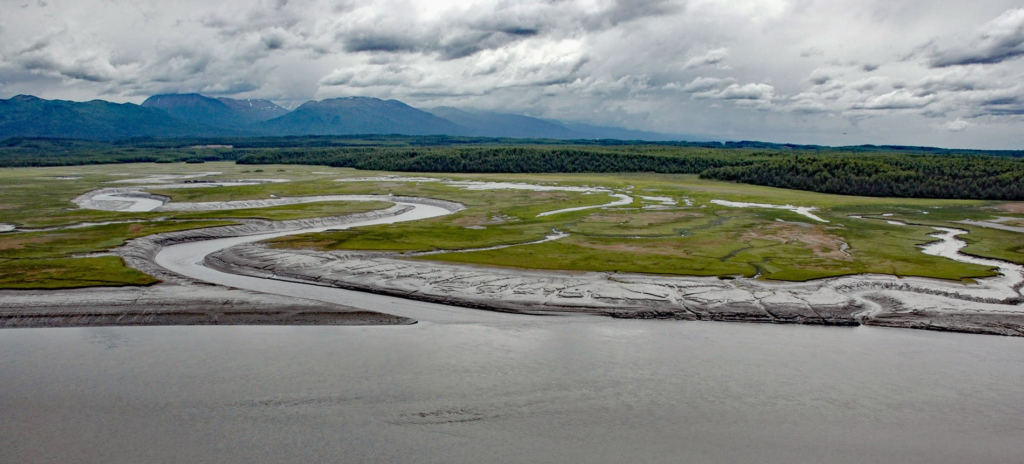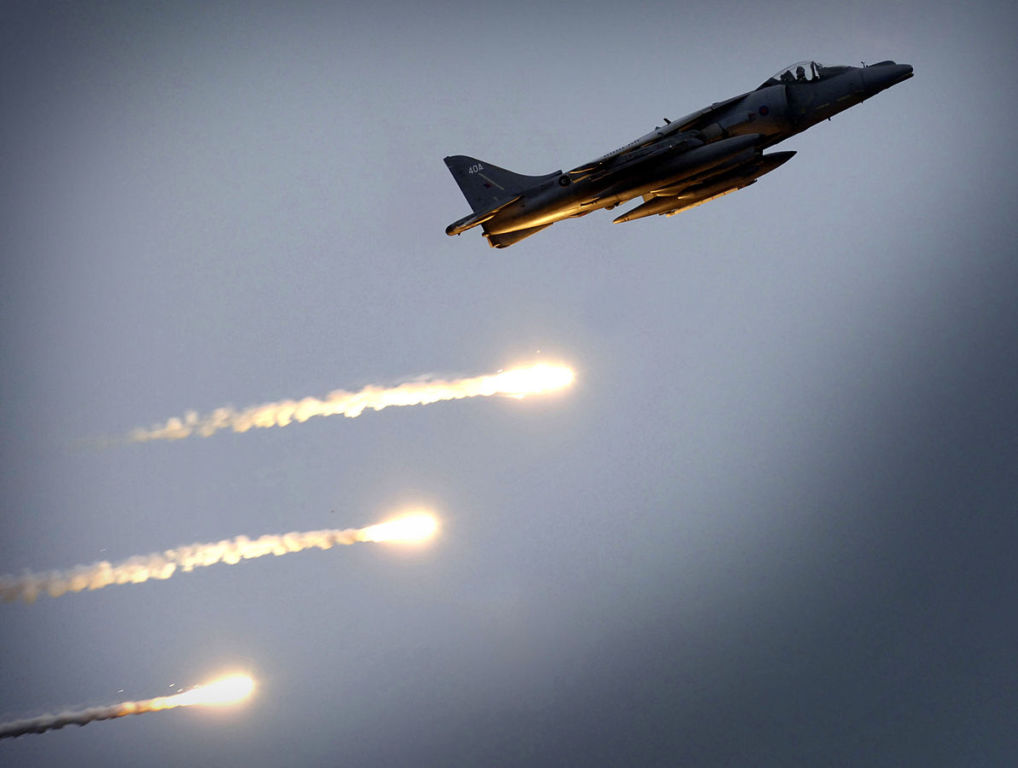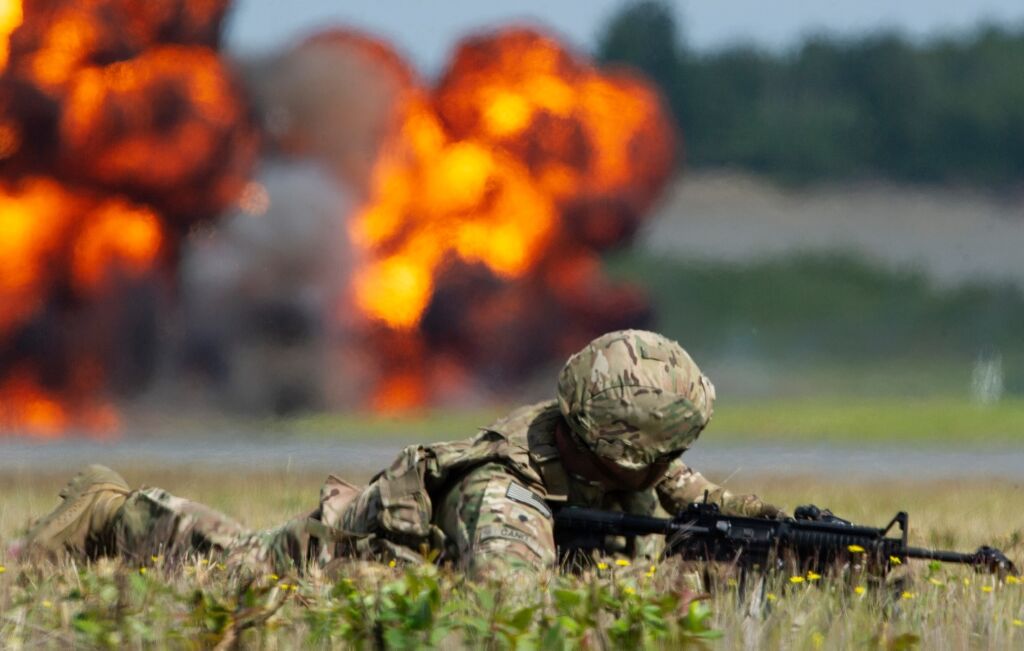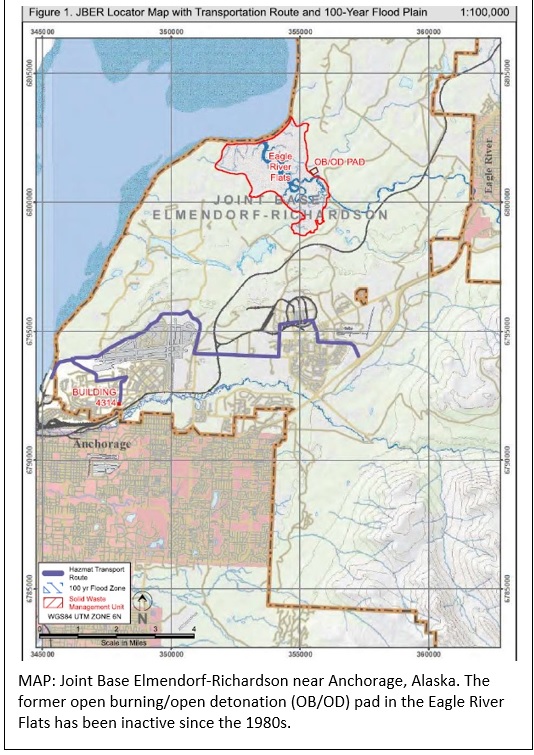
Anchorage, ALASKA — For more than 40 years, the U.S. Environmental Protection Agency (EPA) has deferred cleanup and closure of a former hazardous waste burning area at Joint Base Elmendorf-Richardson in Alaska. If approved, a pending EPA permit will leave this wound open for generations to come.
According to the draft federal hazardous waste permit, open for public comment until September 7, EPA will only require cleanup and closure of a former burning grounds when the military decides use of a nearby active firing range ceases or when the base itself closes – something that EPA Region 10 acknowledges may not happen for years or even decades.[1]
In formal comments to EPA this week, Citizens for Safe Water Around Badger (CSWAB) together with Alaska Community Action on Toxics (ACAT) object to any further delays in the cleanup of former burn pits at Joint Base Elmendorf-Richardson, emphasizing the consequences of deferred cleanup at military sites like Wisconsin’s Badger Army Ammunition Plant where former burn pits are the source of widespread groundwater contamination that has migrated miles beyond the plant boundary – contaminating drinking water wells and discharging into the Lower Wisconsin Riverway.
Open burning and open detonation (OB/OD) of explosives at Alaska’s Fort Richardson has occurred since at least 1956, according to aerial photography.[2] Disposal through burning was performed either on the ground surface or in an excavated pit. Energetic materials that were treated by OB/OD included fuses, high explosive projectiles, smoke pots, mortar rounds, star clusters, flares, mines, rocket motors, shape charges, detonation cord, dynamite, and some flammable solids.[3]
Waste explosives, when burned or detonated in the open air, have the potential to release heavy metals, perchlorate, particulate matter, per- and polyfluoroalkyl substances (PFAS), dioxins/furans, explosive compounds, and other toxic and hazardous contaminants to the environment, according to EPA Headquarters.[4]
 PFAS are added to improve the performance and stability of certain military explosives and munitions. Infrared countermeasure flares, for example, are designed to protect rotary- and fixed-wing aircraft from infrared guided (heat seeking) missiles. Pyrotechnic compositions of magnesium/Teflon/Viton (MTV) are widely used in military flares and for igniting the solid propellant of a rocket motor. Often referred to as “decoy” flares, countermeasure flares are comprised of as much as 45% PFAS (fluoropolymers).[5]
PFAS are added to improve the performance and stability of certain military explosives and munitions. Infrared countermeasure flares, for example, are designed to protect rotary- and fixed-wing aircraft from infrared guided (heat seeking) missiles. Pyrotechnic compositions of magnesium/Teflon/Viton (MTV) are widely used in military flares and for igniting the solid propellant of a rocket motor. Often referred to as “decoy” flares, countermeasure flares are comprised of as much as 45% PFAS (fluoropolymers).[5]
PFAS, dioxins, perchlorate, lead, mercury and other persistent, bioaccumulative, and toxic chemicals are a class of chemicals that resist degradation and persist in the environment for extensive periods. As a result of their persistence, when these chemicals are consumed, they bioaccumulate in the fat tissues, bones, and brain of living organisms. Many of these same contaminants are also highly mobile in the environment, readily migrating from soil to surface water and groundwater.
The OB/OD pad is a graded upland gravel clearing adjacent to the Eagle River Flats (ERF) wetlands and adjacent to the ERF impact area. The 16-acre pad borders an estuarine salt marsh on the south side of Knik Arm in upper Tikahtnu (Cook Inlet).[6]
Joint Base Elmendorf-Richardson lies within traditional lands of the Dena’ina northern Athabascan tribes of Cook Inlet and both tribal members and tribal governments have an enduring interest in the management of these lands. Agreement documents between JBER and the Native Village of Eklutna and Chickaloon Native Village formally acknowledge the government-to-government relationship and mutual areas of concern and support. Three federally recognized native tribes, Native Village of Eklutna, Chickaloon Native Village, and Knik Tribe are primary points of contact for Alaska Native consultation, Air Force officials wrote.[7]
According to U.S. EPA Region 10, the active use of the OB/OD area is not currently authorized and hasn’t been since the 1980s. The unit is unused and not authorized for any open burning or open detonation activities, EPA affirmed. No waste treatment is allowed at the OB/OD. The draft permit addresses the OB/OD only insofar as it requires federal RCRA closure of the OB/OD when use of the active firing range ceases or when Joint Base Elmendorf-Richardson (JBER) itself closes, EPA officials said.[8]
 The draft EPA permit proposes that any potential harmful effects of OB/OD will be addressed after the military decides to initiate closure activities, acknowledging that the Agency understands that “JBER does not expect to make such a decision for many years, if not decades (emphasis added)”.[9],[10]
The draft EPA permit proposes that any potential harmful effects of OB/OD will be addressed after the military decides to initiate closure activities, acknowledging that the Agency understands that “JBER does not expect to make such a decision for many years, if not decades (emphasis added)”.[9],[10]
Groundwater beneath the OB/OD Pad is found at depths of about 4 to 10 meters (13 to 32 feet) below ground surface. Previous studies indicate that the groundwater movement patterns are strongly influenced by both the tides and the river.[11]
Water is known to recharge the groundwater system of JBER in several ways: groundwater seeps from bedrock fractures into the sediments along the Chugach Mountains to the east; snowmelt and rainfall infiltrate to the groundwater; and streams feed groundwater in areas where the elevation of the stream is above the water table. Discharge of the aquifer is either by groundwater flow to Knik Arm or into streams (e.g., Ship Creek, Eagle River) that ultimately discharge into Knik Arm.[12]
The 1989 RCRA Facility Assessment and Visual Site Inspection for JBER concluded that the site provides a high potential for release of hazardous constituents to surface water and groundwater.[13]
Nearly a decade later, EPA deferred cleanup again. The 1998 Operable Unit C Record of Decision documents that EPA determined it would be prudent to allow final RCRA closure of the OB/OD Pad concurrently with future final clearance of the operating Eagle River Flats (ERF) range.[14]
The OB/OD Pad and the ERF impact area are frequented by a variety of wildlife typical of South central Alaska. Big game animals include moose and black bear. Other wildlife in the area include; wolves, foxes, coyotes, beaver, muskrat, mink, weasel, wolverine, lynx, hare, and numerous rodents. The ERF provide prime habitat for waterfowl and several species of raptors are found in the area, primarily in the ERF.[15]
The Cook Inlet beluga is known to occur in the marine environment offshore of the Eagle River Flats (ERF), where JBER’s Open Burning /Open Detonation (OB/OD) unit is located.
 In total, cleanup and closure of the OB/OD hazardous waste unit at Joint Base Elmendorf-Richardson has already been deferred by EPA for more than 40 years. If approved, the current draft EPA permit will leave this wound open for generations to come.
In total, cleanup and closure of the OB/OD hazardous waste unit at Joint Base Elmendorf-Richardson has already been deferred by EPA for more than 40 years. If approved, the current draft EPA permit will leave this wound open for generations to come.
The pending 2023 draft EPA permit states that JBER is delaying RCRA closure of the burning pad area until after the adjacent operating ERF firing range is closed and cleared.[16] This delay in closure has been approved in accordance with 40 CFR 265.113(b)(1)(i), EPA officials said.[17] (EPA’s public notice cited Part 261 which is incorrect, EPA said.)
40 CFR 265.113 (b) The owner or operator must complete partial and final closure activities in accordance with the approved closure plan and within 180 days after receiving the final volume of hazardous wastes, or the final volume of nonhazardous wastes if the owner or operator complies with all applicable requirements in paragraphs (d) and (e) of this section, at the hazardous waste management unit or facility, or 180 days after approval of the closure plan, if that is later. The Regional Administrator may approve an extension to the closure period if the owner or operator demonstrates that: (1)(i) The partial or final closure activities will, of necessity, take longer than 180 days to complete;
This is not the first time that the use and disposal of munitions at Joint Base Elmendorf-Richardson has been challenged. White phosphorus particles released from range firing concentrated in the sediments of Eagle River Flats (ERF) causing a high mortality rate in waterfowl populations. ERF is an 865-hectare estuarine salt marsh that is completely within the boundaries of Fort Richardson Army Base. The U.S. Army suspended the use of ERF as an active Army impact area in 1989.[18]
 Fort Richardson was joint-based with Elmendorf Air Force Base in 2010 to form Joint Base Elmendorf-Richardson (JBER). JBER is an active Army/Air Force installation that spans 74,297 acres north of Anchorage, Alaska. Fort Richardson is listed on the National Priorities List. As specified in the Fort Richardson Federal Facility Compliance Agreement (FFCA), EPA considers the OB/OD Pad to be a RCRA-regulated SWMU (Solid Waste Management Unit) subject to interim status standards codified in 40 CFR 265.[19]
Fort Richardson was joint-based with Elmendorf Air Force Base in 2010 to form Joint Base Elmendorf-Richardson (JBER). JBER is an active Army/Air Force installation that spans 74,297 acres north of Anchorage, Alaska. Fort Richardson is listed on the National Priorities List. As specified in the Fort Richardson Federal Facility Compliance Agreement (FFCA), EPA considers the OB/OD Pad to be a RCRA-regulated SWMU (Solid Waste Management Unit) subject to interim status standards codified in 40 CFR 265.[19]
The longer cleanup and closure of the OB/OD areas at Joint Base Elmendorf-Richardson are deferred, the greater the RISK to human health and the environment and the greater the CERTAINTY that the military will argue that restoration and cleanup are technically and economically infeasible – leaving this toxic legacy for generations to come.
For all these reasons, we strongly object to any further deferral or delay of cleanup and closure at Joint Base Elmendorf-Richardson.
Laura Olah, Executive Director, Citizens for Safe Water Around Badger
Pamela Miller, Executive Director, Alaska Community Action on Toxics

END NOTES:
[1] U.S. EPA Region 10, Memo re: Endangered Species Act (ESA) Effects Determination for the Joint Base Elmendorf-Richardson RCRA Permit Renewal, July 2023 draft.
[2] Department of the Army, U.S. Army Engineer District, Alaska, RECORD OF DECISION for OPERABLE UNIT C, FORT RICHARDSON, ANCHORAGE, ALASKA, September 1998.
[3] Department of the Army, U.S. Army Engineer District, Alaska, RECORD OF DECISION for OPERABLE UNIT C, FORT RICHARDSON, ANCHORAGE, ALASKA, September 1998.
[4] U.S. EPA Headquarters, Open Burning and Open Detonation (OB/OD) of Waste Explosives Under the Resource Conservation and Recovery Act (RCRA), Office of Resource Conservation and Recovery, Director C. Hoskinson, 7 June 2022.
[5] Citizens for Safe Water Around Badger, Demilitarization of Military Flares as an Uncontrolled Source of PFAS, https://cswab.org/demilitarization-of-military-flares-as-an-uncontrolled-source-of-pfas/
[6] Closure Plan, OB/OD PAD, Joint Base Elmendorf-Richardson, Alaska, Final, (draft permit Attachment 7), November 2022.
[7] U. S. Air Force, Integrated Natural Resources Management Plan Joint Base Elmendorf-Richardson, 29 January 2020.
[8] U.S. EPA Region 10, email communication, B. Feldhahn to Laura Olah, CSWAB, 3 August 2023.
[9] U.S. EPA Region 10, Memo re: Endangered Species Act (ESA) Effects Determination for the Joint Base Elmendorf-Richardson RCRA Permit Renewal, July 2023 draft.
[10] U.S. EPA Region 10, Memo re: Endangered Species Act (ESA) Effects Determination for the Joint Base Elmendorf-Richardson RCRA Permit Renewal, July 2023 draft.
[11] Closure Plan, OB/OD PAD, Joint Base Elmendorf-Richardson, Alaska, Final, (draft permit Attachment 7), Section 3.4.2, November 2022.
[12] FACT SHEET, DRAFT HAZARDOUS WASTE MANAGEMENT FACILITY AND CORRECTIVE ACTION PERMIT, JOINT BASE ELMENDORF-RICHARDSON, ANCHORAGE, ALASKA, EPA NO. AK8 57002 8649, July 2023 draft.
[13] Closure Plan, OB/OD PAD, Joint Base Elmendorf-Richardson, Alaska, Final, (draft permit Attachment 7), Section 2.3, November 2022.
[14] Closure Plan, OB/OD PAD, Joint Base Elmendorf-Richardson, Alaska, Final, (draft permit Attachment 7), Section 2.3, November 2022.
[15] Closure Plan, OB/OD PAD, Joint Base Elmendorf-Richardson, Alaska, Final, (draft permit Attachment 7), Section 3.5.2, November 2022.
[16] Closure Plan, OB/OD PAD, Joint Base Elmendorf-Richardson, Alaska, Final, (draft permit Attachment 7), Section 4.1, November 2022.
[17] Closure Plan, OB/OD PAD, Joint Base Elmendorf-Richardson, Alaska, Final, (draft permit Attachment 7), Section 4.1, November 2022.
[18] U.S. EPA, Water Quality Restored at Eagle River Flats to Revive Bird Population, 2008. https://www.epa.gov/sites/default/files/2015-11/documents/ak_eagleriver.pdf
[19] Closure Plan, OB/OD PAD, Joint Base Elmendorf-Richardson, Alaska, Final, (draft permit Attachment 7), November 2022.
Photograph of students courtesy of Chickaloon Village Traditional Council.
